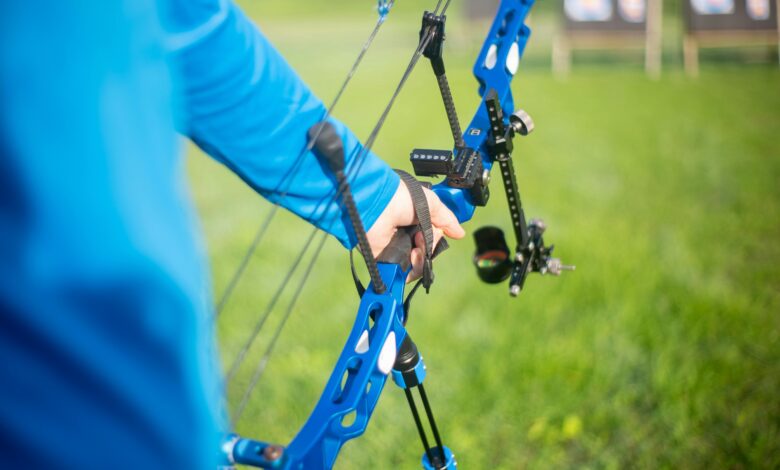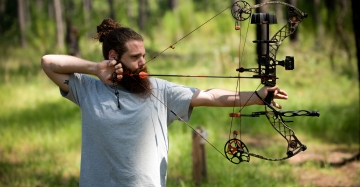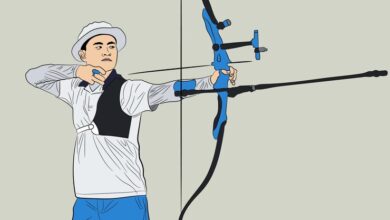What Is String Walking In Archery?

Archery, an ancient sport that has captivated the hearts of enthusiasts for centuries, continues to evolve with new techniques and strategies. One such technique gaining popularity in recent years is string walking.
What Is String Walking In Archery? Walking the string (also called crawling) involves moving your fingers down the string and releasing them.
This post will provide a comprehensive guide to string walking in archery. So, grab your bow and arrow, and let’s embark on this journey together!
What Are The Basic Techniques Of String Walking?
The basic technique of archery involves using a fixed anchor point on the face, while the bowstring is placed at different positions on the chin or jawline. This arrangement allows for adjustments in shot placement.
To determine the distance at which the arrow needs to be shot, the archer walks the string by moving their fingers up or down the string to change the gap between the arrow point and the bow.
Using this method, archers can make precise adjustments to the point of impact. The distance walked on the string corresponds to a specific yardage, allowing for greater accuracy.
In addition, archers can use various reference marks and gaps on the bowstring to further refine their accuracy. By mastering the basic techniques of string walking, archers can consistently hit targets at different distances with heightened precision.
What Are The Key Principles Of String Walking?
There are several key principles to successfully utilize string walking:
- Firstly, it is essential to establish a consistent anchor point, ensuring the bowstring is consistently drawn to the same spot on the face. This allows for accurate and repetitive shooting.
- Secondly, familiarizing oneself with the bow and arrow setup is crucial. Understanding the trajectory and point of impact at different distances is vital to effectively implement string walking.
- Additionally, archers must have a deep understanding of their equipment, including arrow spine and weight, as different combinations may yield different results.
- Lastly, practice and experimentation are necessary to become proficient in string walking, as it requires fine-tuning and adjustments to find the perfect balance between distance and accuracy. By adhering to these principles, archers can enhance their shooting capabilities through this versatile technique.
What Are The Advantages Of String Walking?
The adaptability of string walking is one of its benefits. Archers can swiftly and easily alter the trajectory of the arrow by just shifting where their fingers are on the bowstring.
This eliminates the need for them to rely on intricate sight adjustments or many pin settings to shoot successfully at various distances. String walking also works well in a variety of shooting situations, which is another benefit.
In contrast to conventional sight shooting, which is influenced by variations in weather and illumination, string walking depends on the archer’s muscle memory and proprioception.
This implies that string walking is a useful method for competitive shooting or hunting since it allows an archer to shoot accurately under any kind of weather.
Additionally, string walking promotes a more intuitive and connected shooting experience, as it requires the archer to focus on feeling and reacting to the bow’s natural position rather than relying solely on visual cues.
Overall, the advantages of string walking make it an appealing technique for archers looking to improve their accuracy and adaptability in shooting.
What Are The Disadvantages Of String Walking?
Archery has its fair share of drawbacks, despite its improved precision and the ability to shoot at various distances without changing equipment. One major disadvantage of string walking is the inconsistent use of anchor points.
When the aiming point on the string shifts with each distance modification, it becomes difficult to maintain a constant and repeatable anchor position, which can lead to inconsistent shot execution and accuracy.
In addition, string walking requires a thorough understanding of the arrow’s trajectory at different distances, which requires a lot of practice and precise correction to avoid under or overshooting the target. This technique also demands a high level of focus and concentration, as any deviation from the intended aiming point may result in missed shots or reduced accuracy.
FAQS:
Q1: How does string walking work?
When string walking, the archer crawls—that is, places their hand a certain distance below the arrow nock. To adjust for differences in target distance, the archer can adjust the vertical position where the arrow is aimed by altering the crawl.
Q2: Why is string walking used in archery?
In traditional archery, where the archer lacks the assistance of sights or other aiming equipment, string walking is usually used. It enables the archer to alter their vertical trajectory without altering their bow’s elevation.
Q3: What equipment is needed for string walking?
An archer usually needs a recurve bow or longbow, a bowstring, and arrows to employ the string-walking technique. To protect their fingertips, some archers might additionally put on a glove or finger tab.
Q4: How is the crawl determined in string walking?
It takes trial and error to figure out the crawl, or how far the hand should be positioned below the arrow nock. Depending on the distance to the target and the intended point of impact, archers modify their crawl.
Conclusion:
In conclusion, string walking is a technique in archery that allows for precise aiming at various distances by using the fingers as a reference point on the bowstring.
While it may require practice and adjustment to become proficient, string walking offers a valuable tool for archers seeking accuracy and consistency in their shots.
By understanding the mechanics of this method and implementing it with proper technique and focus, archers can improve their performance and take their skills to new heights.
Whether you are a beginner or an experienced archer looking to expand your arsenal, string walking is definitely worth exploring and mastering. So, grab your bow, string walk with confidence, and aim for those bullseyes!


